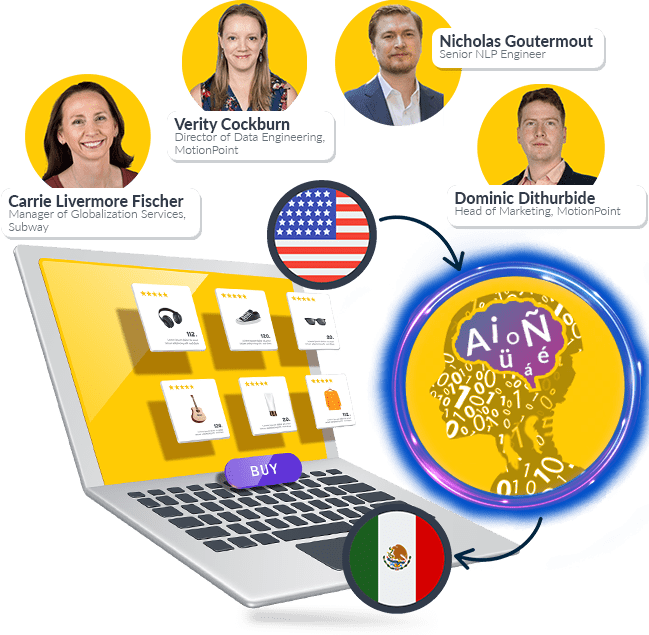The use of Artificial Intelligence (AI) is transforming the way we communicate and interact with each other globally. As our world becomes increasingly connected, the need for efficient and accurate language translation is more important than ever.
A Common Sense Advisory study found that machine translation usage has increased significantly over the past few years. In 2018, 69% of surveyed companies reported using machine translation for at least some of their translation needs, up from 59% in 2017. This trend is expected to continue as more companies adopt MT as a cost-effective and efficient way to handle their translation needs.
With the help of AI and machine translation, businesses, governments, and individuals are breaking down language barriers and making communication easier, faster, and more accessible.
What is AI in Translation?
AI has proven to be useful in an immeasurable number of situations, and the translation industry is no exception to this. The best website translation services are the companies that leverage artificial intelligence and machine learning to help customers save money and prioritize quality will rise above the rest. Using AI allows translation services to generate more accurate, brand-specific work without the need for human linguists.
The most used and advanced form of AI is Neural Machine Translation (NMT). NMTs perform deep-learning to enhance translation quality. They detect patterns in words, sentence structure, and intent that are then used later to provide a more customized output.
There are two types of NMT used in translation:
Generic
Generic NMTs produce accurate, word-for-word translations. An example of a generic NMT is Google Translate. These systems are not customized to a specific domain and are often prone to syntax and grammar errors.
Brand Adaptive
Brand adaptive NMTs are trained based on a system of data and can produce more custom translations. They have the ability to adhere to brand standards and voice and therefore require less post-editing.
Benefits of Using AI and Machine Translation
The most obvious benefit of using AI and machine translation is that it can significantly increase the speed and efficiency of language translation. In the past, translation was a time-consuming and often costly process, requiring human translators to manually translate text from one language to another. With machine translation, however, large amounts of text can be translated quickly and accurately, reducing the time and cost required to communicate across language barriers.
Another significant advantage of using AI and machine translation is the ability to translate a wide range of languages accurately. While human translators are often limited by their knowledge and expertise in specific languages, AI and machine translation can be programmed to translate hundreds of languages accurately and quickly, making communication across borders and cultures much easier.
Furthermore, machine translation can provide a level of consistency in translation that is difficult to achieve with human translators. With AI and machine translation, the translation process is more standardized, meaning that the same translation rules and methods are applied consistently across all translations. This results in a more uniform and predictable translation process, which can be particularly important for businesses and organizations that need to ensure their messages are communicated consistently and accurately across multiple languages and cultures.
What Are the Challenges?
While there are many benefits to using AI and machine translation, there are also several challenges that need to be addressed.
Quality vs. Cost Tradeoff
Despite the improvements in MT quality, there is still a tradeoff between quality and cost. According to a report by Slator, the average cost per word for MT is around $0.10, compared to $0.22 for human translation. However, the quality of MT output is still not at the level of human translation, so companies need to consider this tradeoff when deciding which method to use. While machine translation has come a long way in recent years, it is still far from perfect. Machine translation algorithms can struggle with idiomatic expressions, cultural references, and other nuances that are difficult to capture without human interpretation.
Potential for Bias
AI and machine learning algorithms are only as good as the data they are trained on, and if the data is biased, the resulting translations will also be biased. This can be particularly problematic when translating sensitive or politically charged content, where inaccurate translations can have serious consequences.
Accessibility
While machine translation can be incredibly helpful in breaking down language barriers, it can also create new barriers if the translations are not clear or easy to understand. For example, machine translation can struggle with complex or technical language, resulting in translations that are difficult to follow or understand.
What is the Future of AI and Machine Translation?
According to a report by Common Sense Advisory, the global market for language services and technology was valued at $56 billion in 2019 and is expected to reach $70 billion by 2023. This growth is largely driven by the increasing demand for MT services, which have become more accurate and reliable thanks to AI.
Adaptive Translation™
MotionPoint’s recently launched our new Adaptive Translation ™! It uses a combination of artificial intelligence, algorithmic translation, and translation memory to deliver human quality translation at a fraction of the cost. The AI component involves brand adaptive NMT to learn your brand’s voice and produce consistent, accurate translations.
Looking to the Future
While there are still many challenges to overcome, the benefits of machine translation are clear, and the technology is improving rapidly. As we look to the future, the potential applications of AI and machine translation are vast, and the technology will undoubtedly play a critical role in breaking down language barriers and making communication more accessible and inclusive for everyone.
Get a demo today and see how MotionPoint leverages AI and machine translation to YOUR advantage. Hear more about the topic by downloading our recent webinar on the future of website translation in light of AI. Find it here.
Last updated on May 04, 2023

